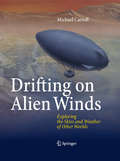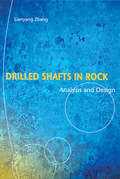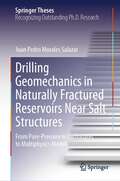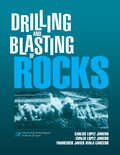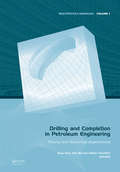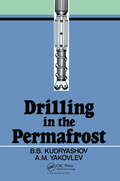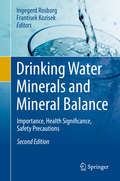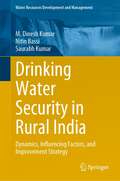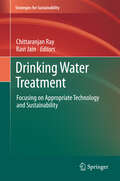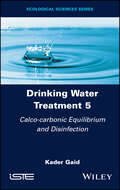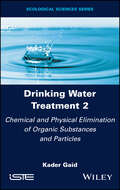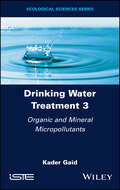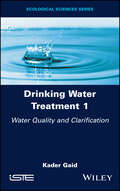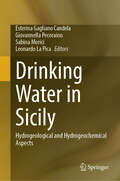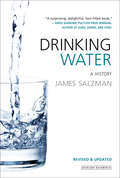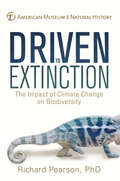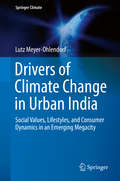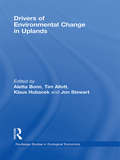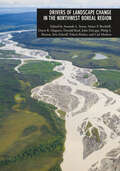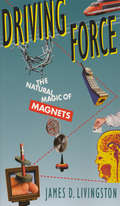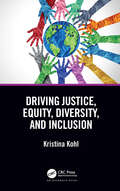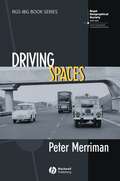- Table View
- List View
Drifting on Alien Winds
by Michael CarrollEver since the Montgolfier's hot air balloon carried a chicken, a goat, and a duck into the Parisian skies, scientists have dreamed of contraptions to explore the atmosphere. With the advent of the space age, new airborne inventions were needed. From the Soviet Venus balloons to the advanced studies of blimps and airplanes for the atmospheres of Mars and Titan, Drifting on Alien Winds surveys the many creative and often wacky ideas for exploring alien skies. Through historical photographs and stunning original paintings by the author, readers also explore the weather on planets and moons, from the simmering acid-laden winds of Venus to liquid methane-soaked skies of Titan.
Drilled Shafts in Rock: Analysis and Design
by Lianyang ZhangDrilled shafts in rock are widely used as foundations of heavy structures such as highway bridges and tall buildings. Although much has been learned about the analysis and design of drilled shafts in rock, all the major findings are published in the form of reports and articles in technical journals and conference proceedings. This book i
Drilling Geomechanics in Naturally Fractured Reservoirs Near Salt Structures: From Pore-Pressure in Carbonates to Multiphysics Models (Springer Theses)
by Juan Pedro Morales SalazarThis book explains different phenomena that occur in Naturally Fractured Reservoirs (NFRs) of carbonate rocks neighboring a salt structure and how it affects well drilling. Prediction of carbonate pore pressure is difficult; therefore, a new set of pore pressure equations for carbonates were developed, accounting for overpressure and depleted conditions. A detailed description of a fully coupled model is shown in order to discuss geomechanics and the coupling of fluid flow in porous media and to achieve a better representation of the mechanics involved in the exploitation of NFRs. Additionally, results of a new model of geomechanics in vuggy carbonate reservoirs are presented. This book also displays a wide discussion, analysis, and numerical implementation of six different salt rheology models. Furthermore, the most representative rheology salt models were studied aside with the fully coupled model of geomechanics and fluid flow in porous media. Finally, it presents an answer to areal case of a well drilled near a salt diapir where anomalous pore pressure was found.
Drilling and Blasting of Rocks
by FranciscoJavier AyalaCarcedoRock breakage with explosives has existed since the seventeenth century when black powder came into use in mining. Since then it has progressed from the invention of dynamite to the use of heavy ANFO. During the past two decades, there have been numerous technical contributions which have brought a better understanding of rock fragmentation with explosives, an improvement in drilling equipment and a noticeable evolution in the development of new explosives and blasting accessories. The Geomining Technological Institute of Spain (ITCE), aware of this progress and of the importance which the breakage process has acquired in mining and civil engineering projects, has ordered the publication of Drilling and Blasting of Rocks. The purpose of this Handbook is to give basic knowledge of the drilling systems, the types of available explosives and the accessories and the parameters that intervene in blast designing, whether controllable or not; at the same time the objectives and contents contribute to improved safety in mining. The Handbook is meant for all professionals who are involved with explosives in mining operations and civil engineering projects, as well as for students of technical schools.
Drilling and Completion in Petroleum Engineering: Theory and Numerical Applications (Multiphysics Modeling)
by Xinpu Shen William Standifird Mao BaiModern petroleum and petrotechnical engineering is increasingly challenging due to the inherently scarce and decreasing number of global petroleum resources. Exploiting these resources efficiently will require researchers, scientists, engineers and other practitioners to develop innovative mathematical solutions to serve as basis for new asset deve
Drilling in the Permafrost: Russian Translations Series, volume 84
by B.B. Kudyashov A.M. YakovlevFirst published in 1991. This volume presents a brief description of the natural conditions of the permafrost regions, the properties of the permafrost and the processes occurring in it, the fundamentals of the heat transfer processes during drilling and the service temperature conditions of the tool. Methods and devices for cooling the flushing media, principles of quality control of flushing agents and the technology and commercial viability of their use during drilling in the permafrost have been considered. The main emphasis in this book is on the drilling technology which uses a variety of flushing agents. The text also includes a description of the technology of utilizing grouting solutions, the theory and practice of drilling with simultaneous freezing of weakly cohesive, moist ground as well as jdrilling holes in the ice-sheets of the circumpolar regions. This book is intended for engineers and technical personnel engaged in drilling for exploratory geological works.
Drinking Water Disinfection By-products: Sources, Fate and Remediation
by Pramod Kumar Pradeep Kumar Mishra Sirajuddin Ahmed Sughosh Madhav Mohd Aamir MazharThis book is devoted to water treatment and it outlines the historical context and regulatory framework surrounding drinking water chlorination, addressing disinfection by-products (DBPs) formation, associated challenges and implications on water quality and human health. In this book, readers will find an overview of various disinfection processes and the latest strategies in DBPs detection and remediation. Divided into 14 chapters, the book begins by offering a background analysis of water disinfection and comparing different disinfection processes and management strategies to mitigate the formation of DBPs. Particular attention is given to both conventional and non-conventional methods used to treat potable water, comparing their effectiveness and potential risks. In subsequent chapters, expert contributors outline the route of exposure and mechanism of action of DBPs, and the toxicological impact of DBPs on human health, providing essential insights for effective risk management strategies. This book also showcases the latest advancements in chlorine applications for water quality control and explores innovative physicochemical and nanotechnology-based approaches to remove DBPs and minimize their formation. Readers will also find in this book a case study of the GIS-based trends analysis of THMs compounds in Indian drinking water supplies. Given its breadth, this book is a valuable resource for researchers, academics, professionals, and policymakers working in environmental sciences, public health and water management, and interested in safer and sustainable drinking water practices.
Drinking Water Minerals and Mineral Balance: Importance, Health Significance, Safety Precautions
by Ingegerd Rosborg Frantisek KozisekFollowing the successful first edition of this book on drinking water quality and health, this new edition puts more focus on the importance of minerals in drinking water. It includes new scientific material and presents additional studies on the negative health effects of reverse osmosis water. The various safety organizations working on drinking water all warn about unhealthy constituents, as well as elements that can cause corrosion or scaling on pipes and installations. However, drinking water may also provide a substantial portion of the daily mineral intake, especially for the elderly and children, or those at risk of deficiencies due to unhealthy eating habits or starvation. Thus, a holistic approach to drinking water is presented in this book and the scope is extended from standards for undesirable substances to the basic mineral composition of water, examining 22 nutrient elements and ions and 21 toxic substances. The function of the nutrients in the body, symptoms of deficiency and overload, and advantages of the minerals from drinking water are presented, as well as symptoms of toxic elements from drinking water. The authors also suggest healthy ranges of minerals and mineral ratios for drinking water. The book offers a valuable resource for the health evaluation of drinking waters, for private well owners, public water producers and safety organizations alike.
Drinking Water Security in Rural India: Dynamics, Influencing Factors, and Improvement Strategy (Water Resources Development and Management)
by Nitin Bassi M. Dinesh Kumar Saurabh KumarThis book highlights the multi-pronged strategy for achieving sustainable rural domestic water supply in India. It deepens the understanding of groundwater (predominant source of water supply) behaviour in response to natural processes in different geological settings, analyses the factors influencing the performance of water supply schemes; identifies the conditions under which groundwater-based drinking water sources become sustainable, suggests measures for improving the sustainability of drinking water wells in hard rock regions (covering 2/3rd of India’s geographical area), presents a decision-making framework for planning rural water supply schemes in the country for ensuring long-term sustainability, and suggests physical strategies and policy measures for achieving them.The analyses for development and validation of various models that explain groundwater system behaviour and performance of rural water supply schemes are undertaken for different geological settings in Maharashtra, as the state represents a microcosm of the various hydrological, topographical, and geohydrological conditions encountered in the country. The final analysis for proposing nation-wide strategies considers the various hydrological, geological, geohydrological, and topographical and climatic settings and groundwater contamination and pollution in the country.
Drinking Water Treatment
by Ravi Jain Chittaranjan RaySustainable technologies for water supply are urgently needed if water has to be supplied to billions of less fortunate people with inadequate access to water. These technologies must be simple, less expensive, less energy intensive, and easy to maintain for their adaptation among the poor masses. Four appropriate technologies are discussed here: solar pasteurization, membrane desalination, natural filtration (riverbank filtration), and solar distillation. Solar pasteurization can be a useful means of producing water at remote, but sunny locations where fuel may not be easily available for boiling water. Membrane desalination will remain as a viable means of drinking water production for individual households to large communities. Various membrane filtration techniques as well as the means to "democratize" membrane filtration have been presented. Riverbank filtration is a "natural" filtration technique where drinking water is produced by placing wells on the banks of rivers. The riverbed/bank material and the underlying aquifer act as natural filters to remove pollutants from river water. Solar distillation can be a viable method of drinking water production for individual households to small communities without the input of external energy. Sustainability framework and technology transfer are discussed through transdisciplinary analysis.
Drinking Water Treatment, Calco-carbonic Equilibrium and Disinfection
by Kader GaidToday, hundreds of millions of people drink contaminated water without knowing it. Yet water treatment technologies can effectively eliminate contamination and can supply urban and rural populations with safe drinking water in a secure way. For almost two centuries, the huge number of treatments available to guarantee water quality has grown alongside technological progress, the strengthening of industry norms and the reinforcement of consumer expectations. New treatment methods have been developed according to the advancement of knowledge and new sanitary regulations. This five-volume book sets out to clearly present the variety of treatments available along with their performance, limitations and conditions of use as well as ways to combine them to produce safe drinking water, which is a basic need essential to everyday life. The author shares his expertise acquired at Veolia, a company that is a world leader in water services and sanitation, desalination of sea water and the recycling of wastewater. Founded in France in 1853 to bring safe water to populations and to protect them from waterborne epidemics which ravaged cities, its history is intertwined with that of water treatment.
Drinking Water Treatment, Chemical and Physical Elimination of Organic Substances and Particles
by Kader GaidToday, hundreds of millions of people drink contaminated water without knowing it. Yet water treatment technologies can effectively eliminate contamination and can supply urban and rural populations with safe drinking water in a secure way.For almost two centuries, the huge number of treatments available to guarantee water quality has grown alongside technological progress, the strengthening of industry norms and the reinforcement of consumer expectations. New treatment methods have been developed according to the advancement of knowledge and new sanitary regulations.This five-volume book sets out to clearly present the variety of treatments available along with their performance, limitations and conditions of use as well as ways to combine them to produce safe drinking water, which is a basic need essential to everyday life.The author shares his expertise acquired at Veolia, a company that is a world leader in water services and sanitation, desalination of sea water and the recycling of wastewater. Founded in France in 1853 to bring safe water to populations and to protect them from waterborne epidemics which ravaged cities, its history is intertwined with that of water treatment.
Drinking Water Treatment, Membranes Applied to Drinking Water and Desalination
by Kader GaidToday, hundreds of millions of people drink contaminated water without knowing it. Yet water treatment technologies can effectively eliminate contamination and can supply urban and rural populations with safe drinking water in a secure way. For almost two centuries, the huge number of treatments available to guarantee water quality has grown alongside technological progress, the strengthening of industry norms and the reinforcement of consumer expectations. New treatment methods have been developed according to the advancement of knowledge and new sanitary regulations. This five-volume book sets out to clearly present the variety of treatments available along with their performance, limitations and conditions of use as well as ways to combine them to produce safe drinking water, which is a basic need essential to everyday life. The author shares his expertise acquired at Veolia, a company that is a world leader in water services and sanitation, desalination of sea water and the recycling of wastewater. Founded in France in 1853 to bring safe water to populations and to protect them from waterborne epidemics which ravaged cities, its history is intertwined with that of water treatment.
Drinking Water Treatment, Organic and Mineral Micropollutants
by Kader GaidToday, hundreds of millions of people drink contaminated water without knowing it. Yet water treatment technologies can effectively eliminate contamination and can supply urban and rural populations with safe drinking water in a secure way. For almost two centuries, the huge number of treatments available to guarantee water quality has grown alongside technological progress, the strengthening of industry norms and the reinforcement of consumer expectations. New treatment methods have been developed according to the advancement of knowledge and new sanitary regulations. This five-volume book sets out to clearly present the variety of treatments available along with their performance, limitations and conditions of use as well as ways to combine them to produce safe drinking water, which is a basic need essential to everyday life. The author shares his expertise acquired at Veolia, a company that is a world leader in water services and sanitation, desalination of sea water and the recycling of wastewater. Founded in France in 1853 to bring safe water to populations and to protect them from waterborne epidemics which ravaged cities, its history is intertwined with that of water treatment.
Drinking Water Treatment, Water Quality and Clarification
by Kader GaidToday, hundreds of millions of people drink contaminated water without knowing it. Yet water treatment technologies can effectively eliminate contamination and can supply urban and rural populations with safe drinking water in a secure way. For almost two centuries, the huge number of treatments available to guarantee water quality has grown alongside technological progress, the strengthening of industry norms and the reinforcement of consumer expectations. New treatment methods have been developed according to the advancement of knowledge and new sanitary regulations. This five-volume book sets out to clearly present the variety of treatments available along with their performance, limitations and conditions of use as well as ways to combine them to produce safe drinking water, which is a basic need essential to everyday life. The author shares his expertise acquired at Veolia, a company that is a world leader in water services and sanitation, desalination of sea water and the recycling of wastewater. Founded in France in 1853 to bring safe water to populations and to protect them from waterborne epidemics which ravaged cities, its history is intertwined with that of water treatment.
Drinking Water in Sicily: Hydrogeological and Hydrogeochemical Aspects
by Esterina Gagliano Candela Giovannella Pecoraino Sabina Morici Leonardo La PicaThis book consists of the hydrogeochemical study of the springs of the Sicilian territory used for drinking water purposes. One of the most important issues in the environmental field is the protection of water resources and in particular the safeguarding of water intended for drinking water use. Water resources need a careful prevention of pollution starting from multidisciplinary studies (geology, hydrogeology, geochemistry, geophysics) to understand the territory in order to highlight vulnerable areas and then plan, where necessary, monitoring activities for the control and protection of the resource. The reference is the Piano Regolatore degli Acquedotti (PRGA) of Sicily, Italy (updated in November 2010), which lists all the springs, subdivided by province (a total of 1014), currently used to supply water to Sicilian aqueducts. With regard to the geochemical part, the studies carried out by the INGV, Sezione di Palermo, for the Water Protection Plan for Sicily (2004-2005) were used as basic data. The study of the chemical characteristics of groundwater is of fundamental importance from a hydrogeological point of view as it allows the origin of the water and its evolution to be reconstructed. Springs as a groundwater resource are of considerable importance in relation to the availability of water resources due to the general decrease in precipitation. In the first part of the book all the existing data (flow rates, geochemical parameters, water quality, etc.) are collected and subsequently transferred to GIS software, after appropriate evaluations on the validity of the acquired data. Considering that the subject is quite delicate and involves various aspects (compliance with regulations, vulnerability of groundwater, anthropogenic pollution, etc.), carrying out a purely scientific study allows groundwater to be placed in a broader context than that of legislation aimed exclusively at compliance with the regulations in force.
Drinking Water: A History
by James SalzmanAn in-depth look at the changing approaches that environmentalists, governments, and the open market have taken to water through the lens of world history. When we turn on the tap or twist open a tall plastic bottle, we probably don&’t give a second thought about where our drinking water comes from. But how it gets from the ground to the glass is far more convoluted than we might think. In this revised edition of Drinking Water, Duke University professor and environmental policy expert James Salzman shows how drinking water highlights the most pressing issues of our time. He adds eye-opening, contemporary examples about our relationship to and consumption of water, and a new chapter about the atrocities that occurred in Flint, Michigan. Provocative, insightful, and engaging, Drinking Water shows just how complex a simple glass of water can be.&“A surprising, delightful, fact-filled book.&” —Jared Diamond, Pulitzer Prize–winning author of Guns, Germs, and Steel &“Instead of buying your next twelve-pack of bottled water, buy this fascinating account of all the people who spent their lives making sure you&’d have clean, safe drinking water every time you turned on the tap.&” —Bill McKibben, author of Earth: Making a Life on a Tough New Planet &“Drinking Water effortlessly guides us through a fascinating world we never consider. Even for people who think they know water, there is a surprise on almost every page.&” —Charles Fishman, bestselling author of The Big Thirst and The Wal-Mart Effect &“Salzman puts a needed spotlight on an often overlooked but critical social, economic, and political resource.&” —Publishers Weekly
Drip! Drop! How Water Gets to Your Tap
by Barbara Seuling Nancy TobinExplains the water cycle and introduces experiments.
Driven to Extinction: The Impact of Climate Change on Biodiversity
by American Museum of Natural History Richard PearsonCould more than a million species disappear in the 21st century? Written by a leading scientist in the field, Driven to Extinction draws upon fascinating case studies from around the world, providing balanced and well-reasoned insight into the potential impacts of climate change on the diversity of life. Richard Pearson focuses on the science of the issue, revealing what has happened––as well as what is likely to happen––to some of the worlds weirdest and most wonderful species as global temperatures continue to rise.
Drivers of Climate Change in Urban India: Social Values, Lifestyles, and Consumer Dynamics in an Emerging Megacity (Springer Climate)
by Lutz Meyer-OhlendorfThis study transcends the homogenizing (inter-)national level of argumentation (‘rich’ versus ‘poor’ countries), and instead looks at a sub-national level in two respects: (1) geographically it focuses on the rapidly growing megacity of Hyderabad; (2) in socio-economic terms the urban population is disaggregated by taking a lifestyle typology approach. For the first time, the lifestyle concept – traditionally being used in affluent consumer societies – is applied to a dynamically transforming and socially heterogeneous urban society. Methodically, the author includes India-specific value orientations as well as social practices as markers of social structural differentiation. The study identifies differentials of lifestyle-induced GHG emissions (carbon footprints) and underlines the ambiguity of a purely income based differentiation with regard to the levels of contribution to the climate problem.
Drivers of Environmental Change in Uplands (Routledge Studies in Ecological Economics)
by Jon Stewart Aletta Bonn Tim Allott Klaus HubacekThe uplands are a crucial source of ecosystem services, such as water provision, carbon retention, maintenance of biodiversity, provision of recreation value and cultural heritage. This puts them in the focus of both environmental and social scientists as well as practitioners and land managers.. This volume brings together a wealth of knowledge of the British uplands from diverse but interrelated fields of study, clearly demonstrating their importance in 21st Century Britain, and indicating how we may through interdisciplinary approaches meet the challenges provided by past and future drivers of environmental change.The upland environments are subject to change. They face imminent threats as well as opportunities from pressures such as climate change, changes in land management and related changes in fire risk, increases in erosion and water colour, degradation of habitats, altered wildlife and recreational value, as well as significant changes in the economy of these marginal areas. This book presents up-to-date scientific background information, addresses policy related issues and lays out pressing land management questions. A number of world-class experts provide a review of cutting-edge naturaland social science and an assessment of past, current and potential future management strategies, policies and other drivers of change. After appraisal of key concepts and principles, chapters provide specific examples and applications by focussing on UK upland areas and specifically the Peak District National Park as a key example for other highly valuable upland regions.
Drivers of Landscape Change in the Northwest Boreal Region
by Valerie BarberThe northwest boreal region (NWB) of North America is a land of extremes. Extending more than 1.3 million square kilometers (330 million acres), it encompasses the entire spectrum between inundated wetlands below sea level to the tallest peak in North America. Permafrost gradients span from nearly continuous to absent. Boreal ecosystems are inherently dynamic and continually change over decades to millennia. The braided rivers that shape the valleys and wetlands continually change course, creating and removing vast wetlands and peatlands. Glacial melt, erosion, fires, permafrost dynamics, and wind-blown loess are among the shaping forces of the landscape. As a result, species interactions and ecosystem processes are shifting across time. The NWB is a data-poor region, and the intention of the NWB Landscape Conservation Cooperative is to determine what data are not available and what data are available. For instance, historical baseline data describing the economic and social relationships in association with the ecological condition of the NWB landscape are often lacking. Likewise, the size and remoteness of this region make it challenging to measure basic biological information, such as species population sizes or trends. The paucity of weather and climate monitoring stations also compound the ability to model future climate trends and impacts, which is part of the nature of working in the north. The purpose of this volume is to create a resource for regional land and resource managers and researchers by synthesizing the latest research on the historical and current status of landscape-scale drivers (including anthropogenic activities) and ecosystem processes, future projected changes of each, and the effects of changes on important resources. Generally, each chapter is coauthored by researchers and land and natural resource managers from the United States and Canada.
Driving Force: The Natural Magic of Magnets
by James D. LivingstonDriving Force unfolds the long and colorful history of magnets: how they guided (or misguided) Columbus; mesmerized eighteenth-century Paris but failed to fool Benjamin Franklin; lifted AC power over its rival, DC, despite all the animals, one human among them, executed along the way; led Einstein to the theory of relativity; helped defeat Hitler’s U-boats; inspired writers from Plato to Dave Barry. In a way that will delight and instruct even the nonmathematical among us, James Livingston shows us how scientists today are creating magnets and superconductors that can levitate high-speed trains, produce images of our internal organs, steer high-energy particles in giant accelerators, and—last but not least—heat our morning coffee. From the “new” science of materials to everyday technology, Driving Force makes the workings of magnets a matter of practical wonder. The book will inform and entertain technical and nontechnical readers alike and will give them a clearer sense of the force behind so much of the working world.
Driving Justice, Equity, Diversity, and Inclusion
by Kristina KohlNavigating the volatility, uncertainty, complexity, and ambiguity (VUCA) characterizing the business world in the 21st century requires a new paradigm focused on an integrated bottom line – planet, people, and profit (PPP). Global trends include resource scarcity and growing inequities in income, wealth, education, and healthcare. Stakeholders are demanding that organizations address systemic barriers to promote justice and equity within organizations and across broader social systems. Transformational change requires leadership to analyze internal and external systems through a social and environmental justice lens. Despite a growing focus on justice, equity, diversity, and inclusion, the imbalance of power remains within our institutions, organizations, and social systems. To move the needle, leaders can turn to Driving Justice, Equity, Diversity, and Inclusion, which explains developing a North Star vision and creating a strategy to redesign organizational process and systems, as well as leveraging tools for data-driven decision-making. It presents a framework to build an inclusive organization as well as a model to engage and support senior and middle management beginning the process of capacity building and systemic change. By layering in AI and other technologies to support data-driven decision-making, the book guides leaders in navigating their organization’s journey along the maturity continuum to achieve their North Star vision of becoming a just and equitable organization. The book also helps managers to Assess ecosystems and organizational systems that justice, equity, diversity, and inclusion impact Take a deeper dive into transformational and operational components to gain insights on the deep systemic realignment of the North Star vision Identify and engage with diverse stakeholders to gain perspective and understand issues crucial for transformative change Leverage people-centered design to create a process promoting diversity of voices and to better align outcomes with shared organizational vision Use data to drive decision-making and reduce bias by removing intuition from the decision-making process Leverage the book's frameworks to drive collaborative systemic change Adapt insights highlighted in multiple interviews with DEI practitioners Benefit from lessons learned and best practices featured in the book's case studies This book features a primer, which is a quick reference guide to key terms, concepts, and definitions. It helps to define justice, equity, diversity, inclusion, and other key terms, such as unconscious bias, stereotypes, and microaggressions. It also features a toolkit, which includes checklists to help managers lead organizations to realize their own North Star vision.
Driving Spaces: A Cultural-Historical Geography of England's M1 Motorway (RGS-IBG Book Series #85)
by Peter MerrimanPeter Merriman traces the social and cultural histories and geographies of driving spaces through an examination of the design, construction and use of England’s M1 motorway in the 1950s and 1960s. A first-of-its-kind academic study examining the production and consumption of the landscapes and spaces of a British motorway An interdisciplinary approach, engaging with theoretical and empirical work from sociology, history, cultural studies, anthropology and geography Contains 38 high quality illustrations Based on extensive, original archive work
